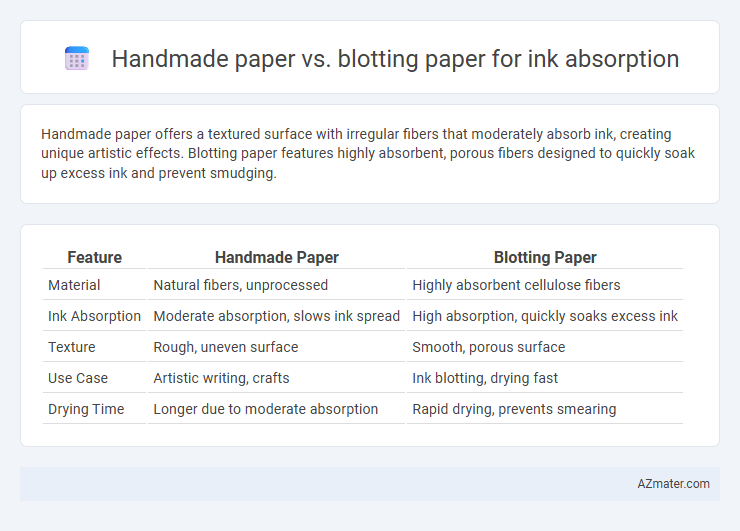Handmade paper offers a textured surface with irregular fibers that moderately absorb ink, creating unique artistic effects. Blotting paper features highly absorbent, porous fibers designed to quickly soak up excess ink and prevent smudging.
Table of Comparison
| Feature | Handmade Paper | Blotting Paper |
|---|---|---|
| Material | Natural fibers, unprocessed | Highly absorbent cellulose fibers |
| Ink Absorption | Moderate absorption, slows ink spread | High absorption, quickly soaks excess ink |
| Texture | Rough, uneven surface | Smooth, porous surface |
| Use Case | Artistic writing, crafts | Ink blotting, drying fast |
| Drying Time | Longer due to moderate absorption | Rapid drying, prevents smearing |
Introduction to Handmade Paper and Blotting Paper
Handmade paper is crafted from natural fibers, offering a textured surface that absorbs ink slowly and unevenly, ideal for artistic calligraphy and ink-based artworks. Blotting paper, composed of highly absorbent cellulose fibers, rapidly soaks up excess ink to prevent smudging and promote quick drying in writing and printing applications. The inherent differences in fiber composition and surface texture define their specific ink absorption capabilities and usability.
Understanding Ink Absorption in Paper Types
Handmade paper features a rougher texture and more porous surface, allowing ink to absorb deeply and evenly, reducing smudging and feathering. Blotting paper, designed specifically for rapid ink absorption, has a highly absorbent and fibrous structure that quickly soaks excess ink, preventing smears on writing surfaces. Understanding these differences helps select the appropriate paper type for calligraphy, printing, or artistic projects requiring precise ink control.
Composition and Manufacturing of Handmade Paper
Handmade paper is crafted from natural fibers like cotton, hemp, or linen, beaten and formed by hand, resulting in a thicker, more textured surface with varying porosity that affects ink absorption. The manual papermaking process creates irregular fiber distribution, enhancing its absorbency and creating a unique interaction with ink compared to blotting paper. Blotting paper is manufactured using highly absorbent cellulose fibers pressed and processed to maximize rapid ink uptake, whereas handmade paper's artisanal composition allows for slower, more controlled ink absorption ideal for calligraphy and art.
Blotting Paper: Structure and Purpose
Blotting paper features a highly porous and absorbent structure designed specifically to quickly soak up excess ink from writing surfaces, preventing smudging and promoting faster drying times. Its cellulose fibers are loosely packed, allowing for rapid ink absorption without spreading, making it ideal for managing ink on fountain pen or calligraphy artworks. Compared to handmade paper, which has variable texture and thickness mainly for artistic or decorative purposes, blotting paper's engineered texture serves a precise functional role in ink absorption and preservation of clean writing lines.
Key Differences in Texture and Porosity
Handmade paper features an uneven, textured surface with irregular porosity, allowing moderate ink absorption that prevents excessive spreading while maintaining rich color depth. Blotting paper, characterized by its highly porous and soft texture, excels in rapid ink absorption, effectively preventing smudging but often causing quicker ink diffusion. The key difference lies in handmade paper's balanced porosity for controlled ink retention versus blotting paper's maximal porosity designed to draw excess ink away instantly.
Ink Absorption Tests: Handmade vs Blotting Paper
Ink absorption tests reveal that handmade paper typically exhibits lower absorption rates due to its denser fiber structure, resulting in slower ink drying times and potential smudging. Blotting paper, conversely, is engineered with high porosity and capillary action to rapidly absorb ink, making it ideal for reducing smears and controlling excess ink. Comparative analysis demonstrates blotting paper's superior efficiency in ink absorption, especially in calligraphy and fountain pen applications.
Applications in Calligraphy and Art
Handmade paper offers superior texture and natural fiber composition, enhancing ink absorption and providing rich, expressive strokes favored in calligraphy and fine art. Blotting paper excels at rapid ink absorption, preventing smudging and preserving the clarity of detailed pen work, making it essential for drying ink in both calligraphy and watercolor techniques. Artists and calligraphers select handmade paper for visual depth and blotting paper for efficient drying, optimizing their creative processes.
Environmental Impact and Sustainability
Handmade paper, crafted from natural fibers such as cotton or hemp, offers superior environmental sustainability due to its biodegradable components and often uses recycled or eco-friendly materials, resulting in lower carbon footprints. Blotting paper, typically mass-produced from wood pulp with chemical processing, may contribute to deforestation and chemical waste, presenting higher ecological concerns despite efficient ink absorption properties. Choosing handmade paper supports sustainable forestry and reduced pollution, aligning better with eco-conscious practices in ink absorption and paper usage.
Cost and Availability Comparison
Handmade paper generally has a higher production cost due to labor-intensive processes and limited large-scale manufacturing, making it less widely available compared to blotting paper. Blotting paper is mass-produced using specialized absorbent fibers, resulting in lower costs and easier availability across stationery and art supply markets. The affordability and consistent quality of blotting paper make it a more practical choice for ink absorption in everyday use.
Conclusion: Choosing the Right Paper for Ink Absorption
Handmade paper offers a unique texture and moderate ink absorption, ideal for artistic projects that benefit from controlled ink spread and rich texture. Blotting paper features high absorbency designed specifically to quickly soak up excess ink, making it perfect for preventing smudges and maintaining crisp lines in calligraphy or fountain pen writing. Selecting the right paper depends on the project's needs: choose handmade paper for creative effects and blotting paper for efficient ink drying and precision.

Infographic: Handmade paper vs Blotting paper for Ink absorption
 azmater.com
azmater.com